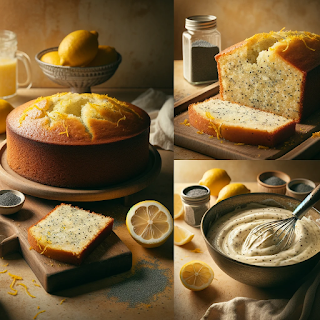Prepare to be delighted by the zesty and enchanting flavors of our Lemon Poppy Seed Cake! This homemade treat is a burst of sunshine on your taste buds, combining the tangy goodness of lemons with the delightful crunch of poppy seeds. Every bite is a journey into citrusy bliss, making it the perfect dessert for any occasion.
Origin Story: Lemon Poppy Seed Cake
The Lemon Poppy Seed Cake is a timeless dessert that balances the bright, zesty flavor of lemons with the subtle crunch of poppy seeds. This cake has a rich history that spans continents and centuries, making it a beloved treat in many cultures.
Historical Roots
The history of poppy seeds dates back to ancient civilizations. They were cultivated by the Sumerians as early as 3400 BC and were widely used in the cuisines of the ancient Egyptians, Greeks, and Romans. Poppy seeds were valued not only for their flavor but also for their supposed medicinal properties.
Lemons, on the other hand, are believed to have originated in Northeast India or China and were brought to Europe by Arab traders in the Middle Ages. The combination of lemon and poppy seeds in baking likely began in Europe, where both ingredients were popular. The bright citrus flavor of lemons provided a perfect contrast to the nutty taste of poppy seeds, creating a delightful and refreshing dessert.
Cultural Significance
Lemon poppy seed cakes and breads have become staples in many countries. In Europe, particularly in Germany and Austria, poppy seeds are a common ingredient in pastries and cakes. In the United States, lemon poppy seed cakes gained popularity in the mid-20th century, often enjoyed as a breakfast treat or a light dessert.
The cake’s appeal lies in its versatility and the simple yet sophisticated flavor combination. It’s a favorite for afternoon tea, brunches, and festive occasions. The addition of a lemon glaze or cream cheese frosting can elevate it from a humble cake to an elegant dessert.
Personal Connection
My journey with lemon poppy seed cake began during a summer vacation in a quaint village in the south of France. The local bakery was renowned for its lemon poppy seed cake, and one bite was enough to make me fall in love with it. The cake was moist and tender, bursting with the fresh flavor of lemons and the delightful texture of poppy seeds.
Inspired by this experience, I set out to recreate the cake in my own kitchen. The key was to find the perfect balance of tartness from the lemons and the right amount of poppy seeds to add texture without overpowering the cake. I experimented with different types of lemon juice and zest, as well as various ratios of poppy seeds, until I achieved a recipe that captured the essence of that unforgettable cake.
Recipe Evolution
Creating the perfect lemon poppy seed cake involved several tweaks and refinements. I discovered that using both lemon juice and zest in the batter added a more intense lemon flavor. Incorporating yogurt or sour cream into the batter helped keep the cake moist and tender. For an extra burst of flavor, I sometimes add a lemon syrup that soaks into the warm cake, enhancing its citrusy goodness.
To finish the cake, I often drizzle a simple lemon glaze over the top. The glaze adds a touch of sweetness and a beautiful shine, making the cake as visually appealing as it is delicious. For special occasions, I might top it with a cream cheese frosting, which pairs wonderfully with the tangy lemon flavor.
Sharing the Tradition
Today, my lemon poppy seed cake is a favorite among friends and family. It’s the cake I bake for spring and summer gatherings, and it never fails to bring smiles and compliments. Each slice is a reminder of that summer in France and the joy of discovering new flavors.
Ingredients:
✅For the Cake:
✅For the Lemon Glaze:
Instructions:
- Preheat your oven to 350°F (175°C). Grease and flour a 9x5-inch loaf pan.
- In a mixing bowl, whisk together the all-purpose flour, poppy seeds, baking powder, baking soda, and salt. Set aside.
- In a separate bowl, cream together the softened unsalted butter and granulated sugar until light and fluffy.
- Beat in the eggs one at a time, ensuring each is fully incorporated.
- Add the lemon zest, fresh lemon juice, and pure vanilla extract to the butter mixture. Mix until well combined.
- Gradually add the dry mixture to the wet mixture, alternating with the sour cream. Begin and end with the dry mixture. Mix until just combined.
- Pour the batter into the prepared loaf pan and spread it evenly.
- Bake in the preheated oven for 50-60 minutes or until a toothpick inserted into the center comes out clean.
- While the cake is baking, prepare the lemon glaze. In a small bowl, whisk together the powdered sugar, fresh lemon juice, and lemon zest until smooth.
- Once the cake is done, remove it from the oven and let it cool in the pan for about 10 minutes. Then, transfer it to a wire rack.
- While the cake is still warm, drizzle the lemon glaze over the top. Allow the glaze to set before slicing and serving.
Pro Tips
- Fresh Lemons: Use fresh lemons for the best flavor. Their zest and juice infuse the cake with bright citrus notes.
- Room Temperature Ingredients: Ensure your butter, eggs, and sour cream are at room temperature for smoother blending.
- Poppy Seed Freshness: Check the expiration date on your poppy seeds to ensure they are fresh and flavorful.
Secret Tips
- Zest Technique: When zesting lemons, use a fine grater or zester, being careful not to include the bitter white pith.
- Even Glazing: For a beautiful glaze, drizzle it over the cake while it's still warm. The warmth helps the glaze soak in and create a lovely finish.
"Indulge in the irresistible allure of our Lemon Poppy Seed Cake, where every slice is a burst of lemony delight. Whether you're enjoying it with a cup of tea, sharing it with loved ones, or savoring it all on your own, this cake is a treat that brightens your day and leaves you craving for more."




